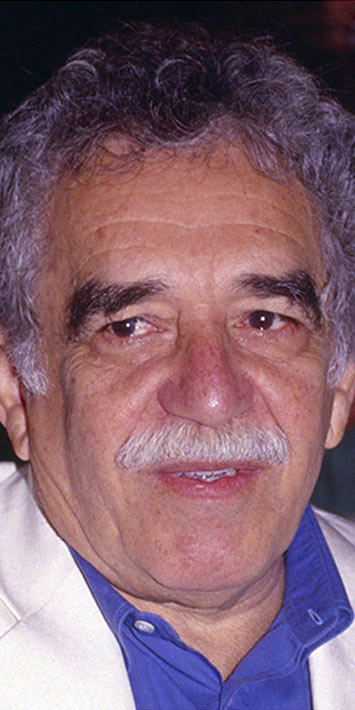Home > Learning resources > Spanish Literature > Gabriel García Márquez
Gabriel García Márquez

Biografía
Gabriel García Márquez nació en Aracataca, Colombia, el 6 de marzo de 1927. Los primeros años de su infancia se desarrollaron junto a sus abuelos maternos y sus tías, ya que sus padres se desplazaron a otra ciudad para abrir una farmacia. Su niñez quedó marcada por sus abuelos: Nicolás Márquez, un veterano de la guerra de los Mil Días, y Tranquilina Iguarán, una abuela imaginativa y supersticiosa. Ambos contaban a Gabriel infinidad de historias, fábulas y leyendas que despertaron un gran interés por la historia y una intensa imaginación en el futuro escritor. A las historias de sus abuelos se sumaron con el tiempo su experiencia vital que daría fruto más tarde en sus novelas.
En 1947, Gabriel García Márquez se trasladó a Bogotá a estudiar leyes. Durante este periodo consolidó su vocación de escritor y publicó su primer cuento, “La tercera resignación”. Nunca se graduó, pero inició entonces su actividad como columnista y se unió al Grupo de la Barranquilla, una asociación de amigos de la literatura. Durante su vinculación a esta asociación, Gabriel leyó a los grandes escritores de la historia de la literatura y perfeccionó su estilo periodístico.
A los 27 años publicó su primera novela, “La hojarasca”, en la que ya se percibían los rasgos más característicos de su obra de ficción. Aunque su notoriedad internacional comienza con la publicación de “Cien años de soledad” (1967), que vendió 8,000 copias en una semana y que más tarde sería considerada uno de los grandes clásicos hispánicos de todos los tiempos. A partir de la aparición de esta novela, su éxito fue fulgurante. Los reconocimientos nacionales e internacionales se sucedieron hasta que en 1982, recibió su mayor premio, el Novel de Literatura, en reconocimiento a “sus novelas e historias cortas, en las que lo fantástico y lo real se combinan en un tranquilo mundo de rica imaginación, reflejando la vida y los conflictos de un continente.”
Entre sus publicaciones más destacadas se encuentran: “Cien años de soledad”, “Crónica de una muerte anunciada”, “El amor en los tiempos de cólera”, “El coronel no tiene quien le escriba”, “El amor y otros demonios” y “Vivir para contarla”.
Biography
Gabriel García Márquez was born in Aracataca, Columbia on March 6, 1927. His early childhood was spent with his maternal grandparents and aunts, since his parents had moved to another city to open a pharmacy. That period would later greatly influence his life and career. His grandparents – Nicolas Marquez, a veteran of the Thousand Days’ War, and Tranquilina Iguarán, an imaginative and superstitious women – would tell Gabriel stories, tales, and legends that fostered in him a passion for history and imagination. Over the years, his vital experience was added to these stories, bearing fruit in his later novels.
In 1947, Gabriel García Márquez moved to Bogota to study law. During that time, he published his first short story, “The Third Resignation”, which solidified his vocation of being a writer. While he never graduated, he did start working as a columnist and joined the Barranquilla group, an association of fans of literature composed of writers and philosophers. It was during this time that Gabriel was first exposed to the great writers of universal literature and improved his journalistic style.
At 27 he published his first novel, “Leaf Storm”. Already noticeable in it were the most characteristic aspects of his writing. However, his masterpiece would have to wait until 1967, when he published “A Hundred Years of Solitude”, selling 8,000 copies in a week. This novel was later considered one of the great Hispanic classics of all time. National and international recognition followed culminating in 1982 when he received his highest award, the Nobel Prize in Literature “for his novels and short stories in which the fantastic and the real are combined in a calm world of rich imagination, reflecting the lives and conflicts of a continent”.
His most prominent publications are: “A Hundred Years of Solitude”, “Chronicle of a Death Foretold”, “Love in the Time of Cholera”, “No One Writes to the Colonel”, “Of Love and Other Demons” and “Living to Tell the Tale”.
Estilo
Aunque Gabriel García Márquez insistió en que el estilo viene determinado por el tema de la novela y el ánimo del momento, su estilo ha sido siempre asociado con el realismo mágico, género en el que de hecho se le considera figura central. En su obra, Gabriel crea un mundo a menudo muy semejante a lo cotidiano, definido técnicamente como representaciones realistas de lo verdadero y de lo irreal.
Style
Although Gabriel García Márquez insisted that style is determined by the topic of the book and the sentiment of the moment, his writing has always been associated to magical realism, gender in which he is actually considered its central figure. In his work, Gabriel often creates a world similar to everyday life, defined technically as realistic representations of the real and the unreal.
Recommended books
As an Amazon Associate we earn commisions from qualifying purchases made through links in this page.
Cien Años de Soledad El amor en los tiempos del cólera es una novela que el premio Nobel colombiano Gabriel García Márquez publicó en 1985. La novela narra la vida de tres personajes a principios del siglo XX en una ciudad costera que, por las descripciones, parece ser Cartagena de Indias. Esta es una historia de amor con una prosa impecable, al mejor estilo del Nobel. One Hundred Years of Solitude (Spanish: Cien años de soledad) is a novel by Nobel Prize winning Colombian author Gabriel García Márquez that was first published in Spanish in 1967. The book is considered García Márquez's masterpiece, metaphorically encompassing the history of Colombia or Latin America. The novel chronicles a family's struggle, and the history of their fictional town, Macondo, for one hundred years. García Márquez acknowledges in his autobiography Living to Tell the Tale that Macondo was based on the towns where he spent his childhood. Like many other novels by Gabriel García Márquez, One Hundred Years of Solitude crosses genres, combining elements of history, magical realism, and pure fiction. |
Cronica de una muerte anunciada En Crónica de una Muerte Anunciada, de Gabriel García Marquez, un hombre regresa al pueblo donde ocurrió un asesinato desconcertante 27 años atrás, con la determinación de descubrir la verdad. Todos parecen estar de acuerdo en que Bayardo San Román, sólo unas horas después de su matrimonio con la bella Angela Vicario, la devuelve por deshonrada a la casa paterna. La atribulada familia fuerza a la novia a revelar el nombre de su primer amante; y los hermanos gemelos de ella anuncian su intención de matar a Santiago Nasar por haber deshonrado a su hermana. Sin embargo, si todos sabían que se iba a cometer un asesinato, ¿por qué nadie trató de impedirlo? Cuanto más se sabe de este asunto, menos se comprende, y cuando la historia al fin se precipita a su inesperada conclusión, una sociedad entera —no sólo un par de asesinos— está siendo enjuiciada. Chronicle of a Death Foretold (original Spanish title: Crónica de una muerte anunciada) is a novella by Gabriel García Márquez, published in 1981. It tells, in the form of a pseudo-journalistic reconstruction, the story of the murder of Santiago Nasar by the two Vicario brothers. Chronicle of a Death Foretold exhibits many of the aspects of a novel written in the magic realist style. For example, the novel makes oblique references to God and clairvoyance. Additionally, it has the magic realism aspect of a warped timeline. |
El amor en los tiempos del cólera Con sagacidad humorística y depurado estilo, García Márquez traza en El Amor en los Tiempos del Colera, la historia excepcional de un amor que no ha sido correspondido por medio siglo. Aunque nunca parece estar propiamente contenido, el amor fluye a través de la novela de mil maneras –alegre, melancólico, enriquecedor, siempre sorprendente. Love in the Time of Cholera (Spanish: ''El amor en los tiempos del cólera'', 1985) is a novel by Gabriel García Márquez about a fifty-year love triangle between Fermina Daza, Florentino Ariza and Doctor Juvenal Urbino set in the late 19th century and the first decades of the 20th century. The novel, a tale of unrequited love, explores the idea that suffering for love is a kind of nobility. One way equates the ‘time of cholera’ with the time of romantic love, thus suggesting that love in this novel is a disease that plagues the body. The title may also be a metaphor for the disease of social irresponsibility. |
More Spanish Learning Resources






